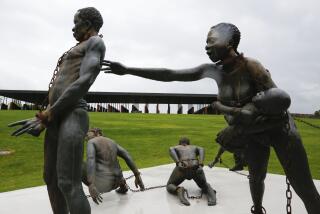An Ugly Piece of American History Is Brought to Light
- Share via
What happened in the Florida mill town called Rosewood on New Year’s Day in 1923 is one of the dirty little secrets of American history, as we discover in Michael D’Orso’s extraordinary book, “Like Judgment Day.”
A “posse” of white men, enraged over reports of an assault on a white woman, descended on the mostly black town in search of the attacker. But the posse turned into a lynch mob, and the lynching turned into a pogrom. As the mob spun wildly out of control, the black population of Rosewood and the town itself were doomed.
“Rosewood was a ghost town now,” writes D’Orso, “its streets crowded with outsiders, its residents scattered into the surrounding swamp, some wearing nothing more than nightshirts, shivering and huddling as they heard the crackle of gunfire and saw smoke climbing toward the clouds.”
As D’Orso tells us in “Like Judgment Day,” the Rosewood massacre revealed itself when a Florida newspaper reporter named Gary Moore began hearing stories of what had happened in the little town while working on a travel piece on weekend getaways in 1982.
“Moore could hardly believe what he heard,” D’Orso writes. “Images of torture and immolation, of unholy terror and unspeakable fear, of murder and mutilation, body parts severed and stored in mason jars still pulled out with a queer sense of pride 60 years later by those into whose hands they had been passed.”
The reporter found his way to a remarkable man named Arnett Doctor, the son of a Rosewood survivor, “an ex-con who spoke with the polish of a professor, a veteran who had carried a carbine in the jungles of Asia and now packed a sidearm on the streets of St. Pete.”
Doctor comes across as the self-appointed curator of the gallery of horrors that exist in the memory of the survivors, and--as it turns out--the champion of those who were scourged and ruined on that terrible day in Rosewood. Doctor invents himself as a paladin who insists on securing what can only be called reparations for the victims of a race war.
As D’Orso follows Arnett Doctor back into Florida history and forward into Florida politics, he expertly unravels the knot of mystery that has hidden the Rosewood massacre for more than half a century. We come to know the men, women and children who lived--and died--in the town, and we understand the richness of the community that was obliterated.
D’Orso allows us to see all the ordinary but revealing details of a small town built on a ticking time bomb of violence: the politics of race, the frictions of class, the ordinary rituals and artifacts of daily life that stand out in high relief when we contemplate the flesh-and-blood human beings who endured it all.
Thus, for example, as he describes the town and the townspeople and their terrible fate, D’Orso’s eyes fall on icons of violence. A sawed-off broom handle with an iron nut attached is a throwing weapon used for killing rabbits in the countryside; a .357 Magnum kept behind the counter of a grocery store is called “a spoiler”; a man who survived a stay in prison recalls how he was beaten with what D’Orso describes as a “steel strap.”
At its best moments, “Like Judgment Day” reminded me of John Berendt’s “Midnight in the Garden of Good and Evil” (Random House, 1994), except that D’Orso brings a sharper edge to his narrative, showing us exactly where Rosewood fits in the history of race and violence in America. When he describes how Arnett Doctor and his fellow activists fought to vindicate the victims of Rosewood by bringing a claim for damages in Florida, we are reminded of the long history of racial violence in America.
And yet the whole point of the claim for reparations--and, indeed, D’Orso’s book--is to confront us with an ugly reality that is obscured by our most cherished myths and dreams.
“The simple truth,” said a sympathetic legislator in the debate over the Rosewood claim, “is the whole world knew what happened in Rosewood, but we have buried it in our collective amnesia.”
D’Orso’s book is graced with the sure touch of a natural storyteller, the discipline of an investigative reporter and the word craft of a novelist. But, to his credit, D’Orso does not “novelize” the Rosewood saga--he understands that his tale of suffering and redemption needs no hype at all.
More to Read
Sign up for our Book Club newsletter
Get the latest news, events and more from the Los Angeles Times Book Club, and help us get L.A. reading and talking.
You may occasionally receive promotional content from the Los Angeles Times.










